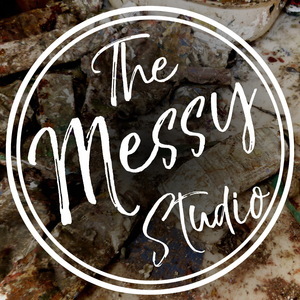What is Unique About Abstraction?
Episode 85 · August 17th, 2019 · 32 mins 36 secs
About this Episode
Intro:
Many people find abstraction very challenging to either create or appreciate because it seems so different from more realistic approaches and it seems hard to find a way in. Although in some ways there are radical differences, there are also some basic similarities with representational art. Today we’ll talk about abstraction in a way that may help your efforts to understand it as an artist or art appreciator.
Realism and abstraction often both get put into fairly rigid boxes in many people’s minds, yet there are also artists who have worked well in both and lots of gray areas in between, or who work back and forth between these styles freely.
All art = translation of some kind. Starting with a source, an idea, something seen, thought, known or felt.
Artist wants to interpret the source in a meaningful way. Which path to take? As an artist, be open, follow your gut, no easy answers with any approach
Quick run through some broad/simplified categories of art approaches: Lots of overlap, these are all continuums-- but for discussion purposes
Realism/Illustrational—as close to what is observed as possible. Can be narrative, allegorical or straight forward observation—artists motivation varies.
Interpretive—subject matter is very important and identifiable BUT artist’s personal style/interpretation is important. emphasis on technique or particular visual elements. Van Gogh example. Surrealism. Expressionism.
Abstraction—ideas, visual input, emotions are interpreted with varying degrees of recognizable subject matter—from some inclusion of subject matter (Picassos abstracted figures) to pure abstraction/no recognizable image/abstract expressionists
like Pollock. Includes Mimimalists like Agnes Martin.
When subject matter is included it tends to be loosely defined, and either a vehicle for emphasis on color or technique, or symbolic
Conceptual art—might be its own category but definitely a lot of overlap with abstraction. Visual image may not be part of it at all. Performance art, ephemeral art.
Abstraction is a huge, broad category. Discussed in early podcast #13 and 14
Not a small box of non=representation only, or any one way of working. So broad in fact that aspects of it can be found in all other approaches.
. Similarities: what is NOT unique about abstraction
**All artists (with exception of some conceptual art) use visual elements /principles of design to create their work—these building blocks are basically purely abstract. An abstract language.
Visual elements—color, value, line, shape, form, texture
Design principles—aspects of composition, distribution of visual weight, contrast, unity
Art school or independent study teaches much of the same basic principles of art to everyone. Important no matter which path you take. (A misperception that abstract artists do not need to know basic skills, that it is entirely free-form. These are very basic tools for all artists. )
Structure and tension are important no matter what the style.
**All artists deal with relationships between parts of their work. A realistic landscape painter is thinking similarly to an abstract painter in placement of shapes, colors, movement of eye throughout the painting.
**Communication—trying to convey a perspective, idea, emotion, interest, bridging the gap between one’s own perception and the viewers
A matter of how your sources or input are translated, more literally or more abstractly.
** growth/development: all serious artists share this goal/ abstraction is certainly not an easy path though some may assume it to be so
Unique aspects of Abstraction:
Creating a different kind of reality/ based on thought, emotion, imagination—tapping into viewer’s subconscious or non-linear thoughts, associations
Emphasis on a few visual elements within one work ---takes viewer’s interpretation away from more illustrational reality. Recognize which elements the artist is focusing on and this can be a basis for understanding the work.
Challenging to viewers: Many people want to see something in the work as a way in—but realize the way in may be something like exploration of color for its own sake, like music without words. No easy labels. Requires a letting go, an immersion, allowing your own feelings and gut responses. Artists have to accept some will never “get” their work.
Integration of numerous sources: unlike more illustrational kinds of art. Can involve a lot of free association, influence from the visual world, memories, pure impulses of color, line or shape.
“Making something out of nothing” – yet there is plenty to work with, it is just not presented in a linear way
Wrap-up:
Sometimes people think as an abstract painter myself I would not appreciate other styles—but the principles of good art carry across styles. I like to point this out so that people open up more to abstraction, and also to help those beginning with abstraction see that it is not an entirely different world.
www.rebeccacrowell.com
www.squeegeepress.com
www.facebook.com/messystudiopodcast
Episode Mentioned:
https://messystudio.fireside.fm/13 (Diving Into Abstraction Part 1)
Summary
